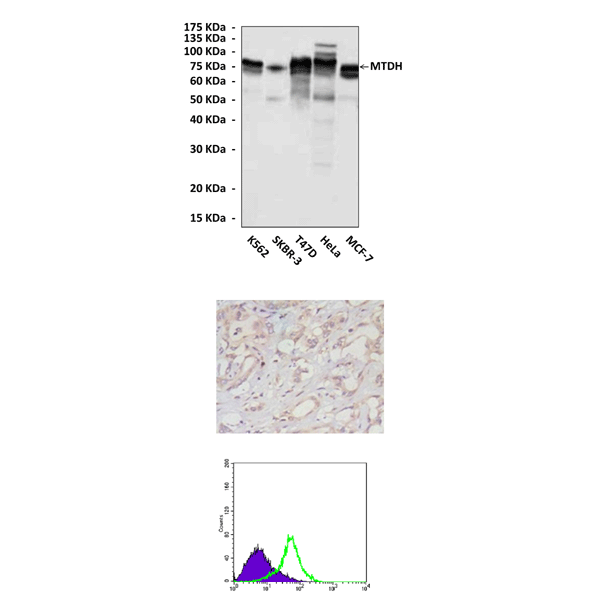Anti-MTDH: Mouse Metadherin Antibody |
 |
BACKGROUND Metadherin (MTDH), also known as astrocyte elevated gene-1(AEG-1), and Lysine-rich CEACAM-1-associated protein(Lyric), was originally identified as an oncogene induced in primary human fetal astrocytes infected with human immunodeficiency virus type 1(HIV-1) or treated with HIV envelope glycoprotein(gp120) or tumor necrosis factor-alpha(TNF-alpha). Human MTDH/AEG-1 mRNA encodes a 582 amino acid protein with a calculated molecular mass of 64 kDa and pI9.3.1 It has been found that MTDH ubiquitously expresses in numerous cell types, elevated levels have also been observed in some human tumor types, such as breast cancer, prostate cancer, hepatocellular carcinoma, neuroblastoma, esophageal squamous cell carcinoma (ESCC) and non-small cell lung cancer (NSCLC). Expression of MTDH could augment anchorage-independent growth. Overexpression of MTDH could inhibit apoptosis induced by serum starvation in immortalized primary human fetal astrocytes (PHFA). Upregulation of MTDH increased lung metastasis of breast cancer cell, as well as migration and invasion of glioma cells. It has been demnonstrated that MTDH promotes tumourigenesis, metastases and chemoresistance. Moreover, it was found recently that MTDH drives one of the steps critical for breast cancer metastasis to the lungs: adhesion to the walls of blood vessels, it had minimal effect on bone and brain metastases, suggesting tissue specificity.2
Several signaling pathways have been found to be associated with MTDH/AEG-1 function, including Ha-ras, PI3K/Akt, NF-kappaB and Wnt/beta-catenin. MTDH could cooperate with oncogenic Ha-ras to increase soft agar colony formation of nontumorigenic immortalized melanocytes and HeLa cells; also it serves as a downstream target gene of Ha-ras in regulating proliferation and transforming activities. By activating the NF-κB pathway, MTDH could increase anchorage-independent growth and invasiveness of HeLa cells. MTDH also activates cell survival pathways through PI3K/Akt signaling. Besides the function of oncogenesis, MTDH was also found to be a lipopolysaccharide (LPS)-responsive gene and involved in LPS-induced inflammatory response via NF-kappaB activation.3
Several signaling pathways have been found to be associated with MTDH/AEG-1 function, including Ha-ras, PI3K/Akt, NF-kappaB and Wnt/beta-catenin. MTDH could cooperate with oncogenic Ha-ras to increase soft agar colony formation of nontumorigenic immortalized melanocytes and HeLa cells; also it serves as a downstream target gene of Ha-ras in regulating proliferation and transforming activities. By activating the NF-κB pathway, MTDH could increase anchorage-independent growth and invasiveness of HeLa cells. MTDH also activates cell survival pathways through PI3K/Akt signaling. Besides the function of oncogenesis, MTDH was also found to be a lipopolysaccharide (LPS)-responsive gene and involved in LPS-induced inflammatory response via NF-kappaB activation.3
REFERENCES
1. Su, P. et al: Diagn Pathol. 5: 38, 2010
2. Hu, G. et al: Cancer Cell 15:9-20, 2009
3. Hu, G. et al: Clin Cancer Res 15:5615–20, 2009
2. Hu, G. et al: Cancer Cell 15:9-20, 2009
3. Hu, G. et al: Clin Cancer Res 15:5615–20, 2009
Products are for research use only. They are not intended for human, animal, or diagnostic applications.
Параметры
Cat.No.: | CP10169 |
Antigen: | Purified recombinant human Metadherin fragments expressed in E. coli. |
Isotype: | Mouse IgG1 |
Species & predicted species cross- reactivity ( ): | Human |
Applications & Suggested starting dilutions:* | WB 1:1000 IP 1:50 IHC 1:200 ICC n/d FACS 1:200 |
Predicted Molecular Weight of protein: | 75 kDa |
Specificity/Sensitivity: | Detects endogenous Metadherin proteins without cross-reactivity with other family members. |
Storage: | Store at -20°C, 4°C for frequent use. Avoid repeated freeze-thaw cycles. |
*Optimal working dilutions must be determined by end user.
Документы
Информация представлена исключительно в ознакомительных целях и ни при каких условиях не является публичной офертой








